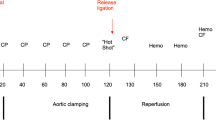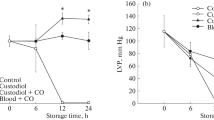Abstract
The effect of adding allopurinol and catalse to hypothermic cardioplegia for ischemic-reperfusion injury was investigated in the isolated rabbit heart. Hearts were divided into two groups, namely: Group C (n=7), which received a hypothermic crystalloid cardioplegic solution alone (4°C), and group T (n=7), which received the hypothermic cardioplegic solution with allopurinol (148 μmol/L)13 and catalase (37 nmol/L).12 The cardioplegic solution was infused continuously into the isolated hearts, which had been placed in ice-cold saline, during a 12 h preservation. Subsequently, the hearts were mounted on a noncirculating, nonpulsatile perfusion circuit using Krebs-Henseleit buffer solution at 37°C for 1 h at a constant perfusion pressure of 75 mm Hg. The left ventricular developed pressure (LVDP), maximum rate of pressure change (max dp/dt), and percent recovery of coronary flow were higher, while the creatine phosphokinase concentration and left ventricular end diastolic pressure (LVEDP) were lower in group T. The tissue malondialdehyde concentration and water content were similar in both groups. Thus, cardiac function after a 12 h preservation was enhanced by the added combination of allopurinol and catalase to the cardioplegic solution, supporting its role in the prevention of free radical reperfusion injury in cardiac preservation.
Similar content being viewed by others
References
Hardy JD, Chavez CM, Kurrus FD, Neely WA, Eraslan S, Turner MD, Fabian LW, Labecki TD (1964) Heart transplantation in man. Developmental studies and report of a case. JAMA 188:1132–1140
Meerson FZ, Kagan VE, Kozlov YP, Belkina LM, Arkhipenko YV (1982) The role of lipid peroxidation in the pathogenesis of ischemic damage and the antioxidant protection of the heart. Basic Res Cardiol 77:465–485
Burton KP, McCord JM, Ghai G (1984) Myocardial alterations due to free-radical generation. Am J Physiol 246:776–783
Shlafer M, Kane PF, Kirsh MM (1982) Superoxide dismutase plus catalase enhances the efficacy of hypothermia cardioplegia to protect the globally ischemic, reperfused heart J Thorac Cardiovasc Surg 83:830–839
Flower RJ, Moncada S, Vane JR (1985) Analgesic-antipyretics and anti-inflammatory agents: Drugs employed in the treatment of gout. In: Gilman AG, Goodman LS, Rall TW, Murad F (eds) The Pharmacological Basis of Therapeutics. Macmillan, New York, p 674
Arnold WL, DeWall RA, Kezdi P, Zwart HHJ (1980) The effect of allopurinol on the degree of early myocardial ischemia. Am Heart J 99:614–624
Johnson DL, Horneffer PJ, Dinatale JM, Gott VL, Gardner TJ (1987) Free radical scavengers improve functional recovery of stunned myocardium in a model of surgical coronary revascularization. Surgery 102:334–340
Werns SW, Shea MJ, Lucchesi BR (1986) Free radicals and myocardial injury: Pharmacologic implications. Circulation 74:1–5
Gardner TJ, Stewart JR, Casale AS, Downey JM, Chambers DE (1983) Reduction of myocardial ischemic injury with oxygen derived free radical scavengers. Surgery 94:423–427
Hammond B, Kontos HA, Hess ML (1985) Oxygen radicals in the adult respiratory distress syndrome in myocardial ischemia and reperfusion injury, and in cerebral vascular damage. Can J Physiol Pharmacol 63:173–187
Stewart JR, Crute SL, Loughlin V, Hess ML, Greenfield LJ (1985) Prevention of free radical-induced myocardial reperfusion injury with allopurinol. J Thorac Cardiovasc Surg 90:68–72
Myers CL, Weiss SJ, Kirsh MM, Shepard BM, Shlafer M (1986) Effect of supplementing hypothermia crystalloid cardioplegic solution with catalase, superoxide dismutase, allopurinol, or deferoxamine on functional recovery of globally ischemic and reperfused isolated hearts. J Thorac Cardiovasc Surg 91:281–289
Chamber DJ, Braimbridge MV, Hearse DJ (1987) Free radicals and cardioplegia: Allopurinol and oxypurinol reduce myocardial injury following ischemic arrest. Ann Thorac Surg 44:291–297
Schoutsen B, Willem de Jong J (1987) Age-dependent increase in xanthine oxidoreductase differs in various heart cell types. Circ Res 61:604–607
Gauduel Y, Duvelleroy MA (1984) Role of oxygen radicals in cardiac injury due to reoxygenation. J Mol Cell Cardiol 16:459–470
Author information
Authors and Affiliations
Rights and permissions
About this article
Cite this article
Nishida, K. The effect of supplementing hypothermic crystalloid cardioplegia with catalase plus allopurinol in the isolated rabbit heart. Surg Today 23, 40–44 (1993). https://doi.org/10.1007/BF00308998
Received:
Accepted:
Issue Date:
DOI: https://doi.org/10.1007/BF00308998




